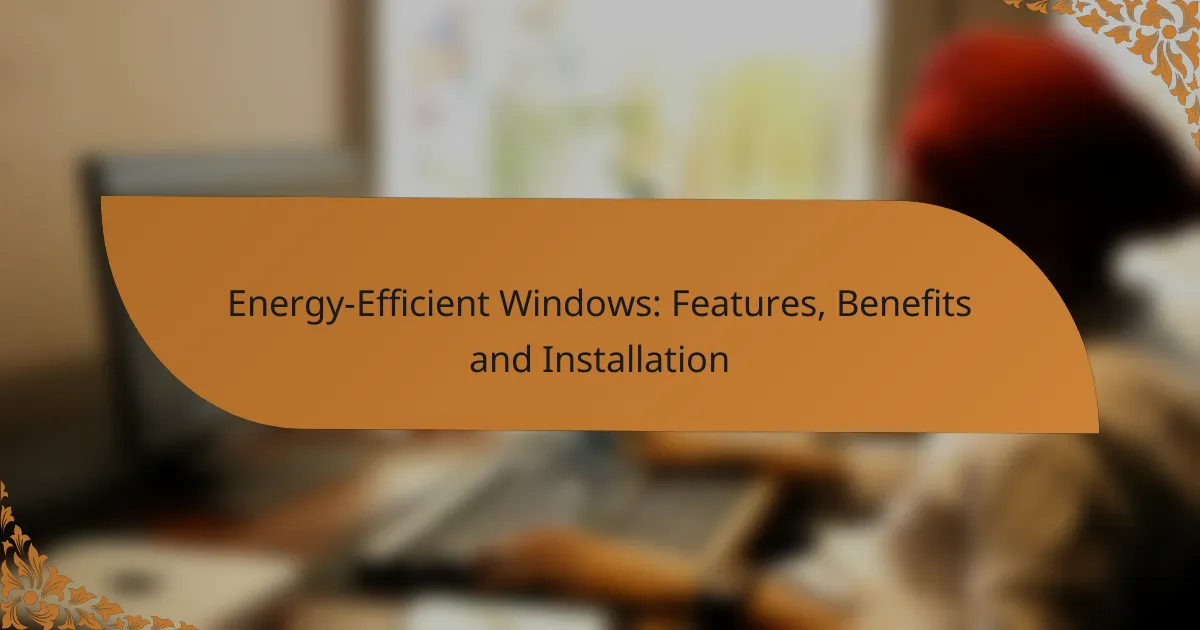Energy-efficient windows are an essential investment for homeowners looking to reduce energy costs and enhance comfort. By minimizing heat transfer through advanced insulating materials and specialized coatings, these windows contribute to a more sustainable living environment. Selecting the right features, such as frame materials and glazing options, is crucial for maximizing their performance and overall effectiveness.
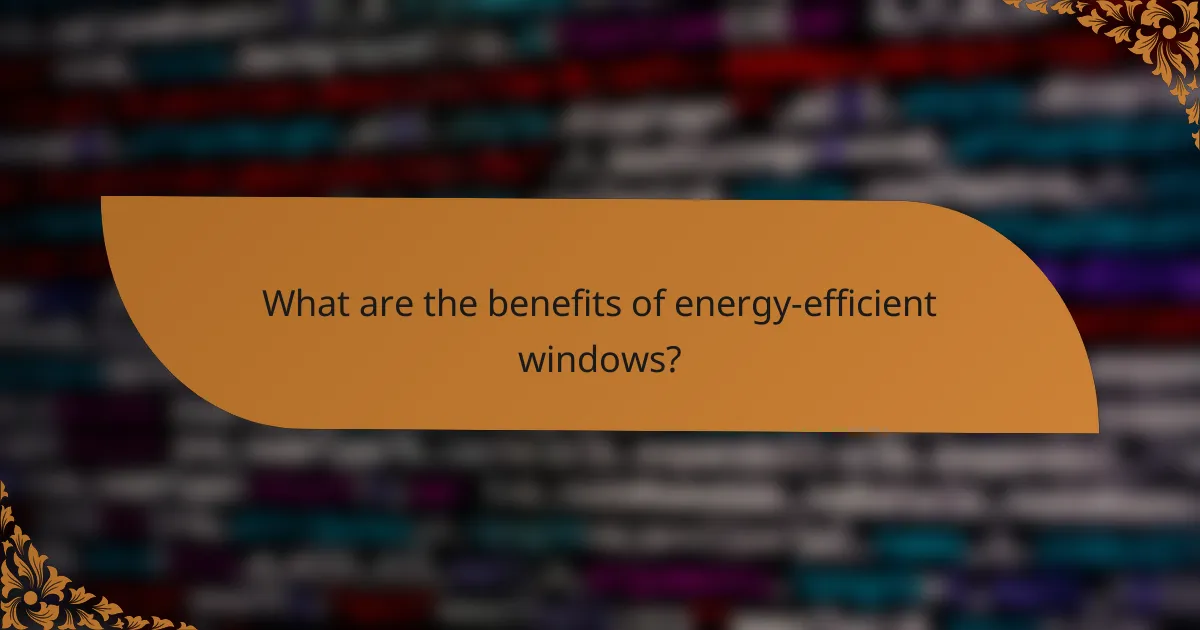
What are the benefits of energy-efficient windows?
Energy-efficient windows offer significant advantages, including lower energy costs, enhanced comfort, and increased property value. These windows are designed to minimize heat loss and gain, making homes more sustainable and cost-effective.
Reduced energy bills
One of the primary benefits of energy-efficient windows is their ability to lower energy bills. By reducing heat transfer, these windows help maintain a consistent indoor temperature, which can lead to savings of 10-25% on heating and cooling costs. Homeowners can expect a return on investment through lower utility expenses over time.
When selecting windows, look for those with a high Energy Star rating or low U-factor, which indicates better insulation properties. This can help ensure that you are making a cost-effective choice.
Improved indoor comfort
Energy-efficient windows contribute to improved indoor comfort by reducing drafts and maintaining a stable temperature. They minimize cold spots near windows during winter and keep interiors cooler during summer, creating a more pleasant living environment year-round.
Consider double or triple-pane windows with low-emissivity (Low-E) coatings to enhance comfort further. These features reflect heat back into the room during winter and block unwanted solar heat in summer.
Enhanced property value
Installing energy-efficient windows can increase your property’s market value. Potential buyers often view these windows as a desirable feature, as they promise lower energy costs and improved comfort. Homes with energy-efficient upgrades tend to sell faster and at higher prices.
Investing in quality windows can yield a return of 70-80% of the initial cost upon resale, making it a smart financial decision for homeowners looking to enhance their property’s appeal.
Noise reduction
Energy-efficient windows can significantly reduce outside noise, creating a quieter indoor environment. This is particularly beneficial for homes located in busy urban areas or near highways, where sound pollution can be a concern.
Look for windows with laminated glass or multiple panes, as these features effectively dampen sound transmission. This improvement can enhance your overall quality of life by providing a more peaceful living space.
Environmental impact
Choosing energy-efficient windows has a positive environmental impact by reducing energy consumption and greenhouse gas emissions. By using less energy for heating and cooling, homeowners contribute to a decrease in reliance on fossil fuels and lower carbon footprints.
Additionally, many energy-efficient windows are made from sustainable materials, further supporting eco-friendly practices. Investing in these windows aligns with broader efforts to promote sustainability and protect the environment for future generations.
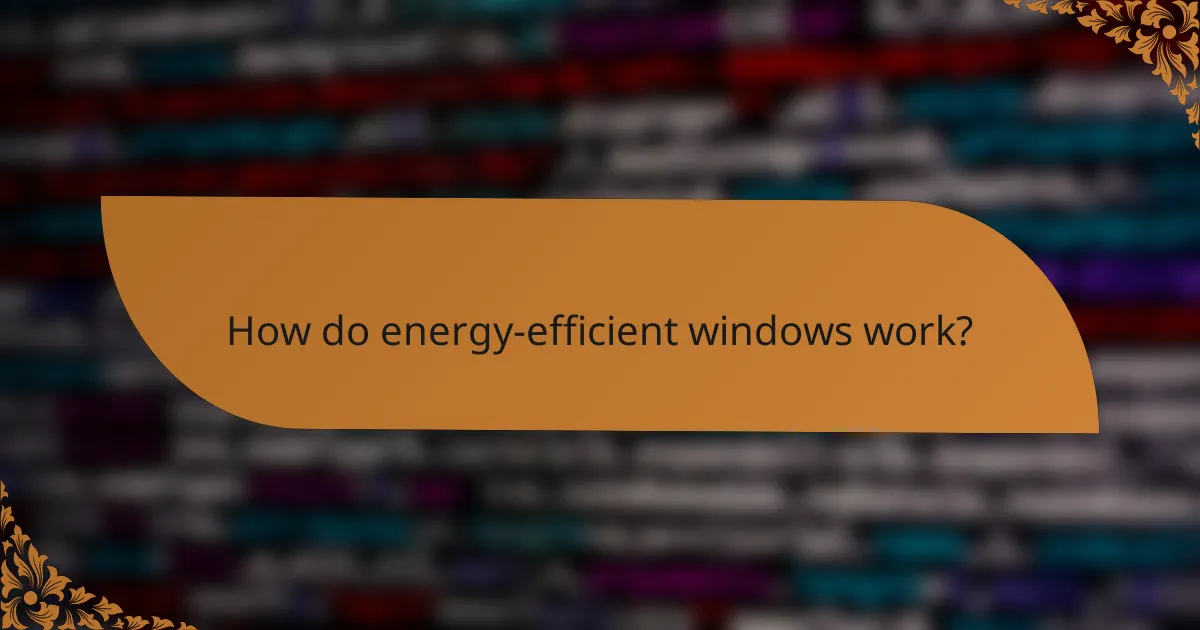
How do energy-efficient windows work?
Energy-efficient windows work by minimizing heat transfer between the interior and exterior of a building. They achieve this through a combination of insulating materials, specialized coatings, and gas fills that enhance thermal performance.
Insulating properties
Insulating properties are crucial for energy-efficient windows, as they help reduce heat loss in winter and heat gain in summer. Common materials used for insulation include double or triple glazing, which consists of multiple panes of glass separated by air or gas-filled spaces. The effectiveness of these windows can be measured by their U-factor, with lower values indicating better insulation.
When selecting windows, consider the frame material as well. Vinyl, fiberglass, and wood frames generally offer better insulation compared to aluminum frames, which can conduct heat more readily. Proper installation is also essential to prevent air leaks that can compromise insulation performance.
Low-emissivity coatings
Low-emissivity (Low-E) coatings are thin, transparent layers applied to window glass that reflect infrared light while allowing visible light to pass through. This feature helps keep heat inside during colder months and blocks excessive heat during warmer months, enhancing overall energy efficiency. Low-E coatings can significantly improve a window’s performance without sacrificing natural light.
When choosing Low-E windows, look for those that meet ENERGY STAR standards, which can vary by region. These windows often come with a specific rating indicating their effectiveness in your local climate, ensuring you select the best option for your needs.
Gas fills
Gas fills refer to the inert gases, such as argon or krypton, that are used between the panes of double or triple-glazed windows. These gases have lower thermal conductivity than air, which helps reduce heat transfer and improve insulation. Windows filled with argon or krypton can enhance energy efficiency by providing better thermal performance compared to air-filled windows.
When considering gas-filled windows, check for the manufacturer’s specifications to ensure the gas fill is properly sealed and has a long lifespan. Over time, gas can leak out, diminishing the window’s insulating properties, so look for warranties that cover this aspect for added peace of mind.

What features should I look for in energy-efficient windows?
When selecting energy-efficient windows, focus on features that enhance insulation, reduce heat transfer, and improve overall energy performance. Key aspects include frame materials, glazing options, and U-factor ratings, which collectively determine a window’s efficiency and effectiveness in maintaining indoor temperatures.
Frame materials
The frame material significantly impacts a window’s energy efficiency. Common options include vinyl, wood, fiberglass, and aluminum, each with unique insulation properties. Vinyl frames are popular for their affordability and low maintenance, while wood offers excellent insulation but requires more upkeep.
Consider the climate when choosing frame materials. In colder regions, materials with better insulation properties, like fiberglass, may be preferable. In warmer areas, low-conductivity materials such as vinyl can help keep homes cool.
Glazing options
Glazing refers to the glass used in windows, which plays a crucial role in energy efficiency. Double or triple-pane glass is recommended as it provides better insulation than single-pane options. The space between the panes can be filled with inert gases like argon or krypton to further reduce heat transfer.
Look for low-emissivity (Low-E) coatings on the glass, which reflect infrared light and help maintain indoor temperatures. These coatings can significantly improve energy efficiency by minimizing heat loss in winter and reducing heat gain in summer.
U-factor ratings
The U-factor measures a window’s overall thermal performance, indicating how well it insulates. A lower U-factor signifies better insulation, making it a critical factor when selecting energy-efficient windows. Aim for windows with U-factors that meet or exceed local energy codes.
For example, in the United States, energy-efficient windows typically have U-factors ranging from 0.20 to 0.30. In Europe, look for windows with U-values below 1.2 W/m²K to ensure compliance with energy efficiency standards. Always check for certifications from organizations like ENERGY STAR to ensure quality and performance.
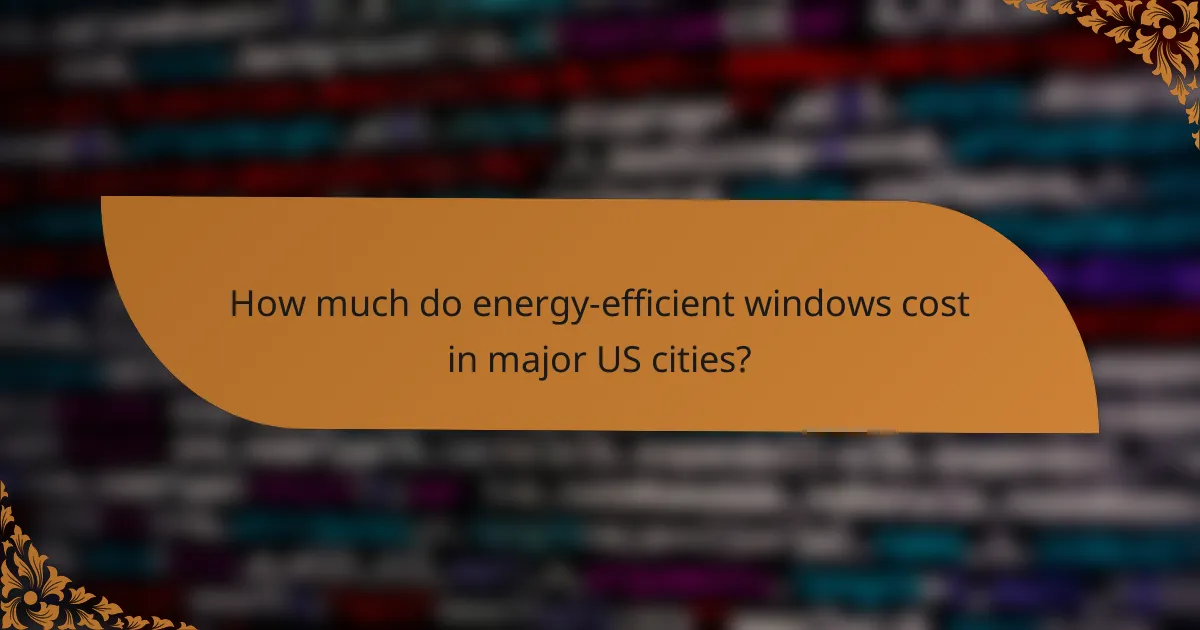
How much do energy-efficient windows cost in major US cities?
The cost of energy-efficient windows varies significantly across major US cities, typically ranging from around $300 to $1,000 per window, depending on factors like materials, installation, and local labor rates. Cities with higher living costs, such as San Francisco or New York, may see prices at the upper end of this range.
Average installation costs
Installation costs for energy-efficient windows can vary, generally falling between $100 and $300 per window. This price can increase if additional work is needed, such as framing or structural modifications. Homeowners should obtain multiple quotes to ensure competitive pricing.
Cost comparison by window type
Different types of energy-efficient windows come with varying costs. For instance, double-pane windows typically range from $300 to $800, while triple-pane options may cost between $500 and $1,200. Vinyl frames are often more affordable than wood or fiberglass, which can influence overall expenses.
Long-term savings
Investing in energy-efficient windows can lead to significant long-term savings on energy bills, potentially reducing heating and cooling costs by 10% to 25%. Additionally, many states offer tax credits or rebates for energy-efficient upgrades, which can further offset initial costs. Homeowners should consider these savings when evaluating the overall investment in new windows.
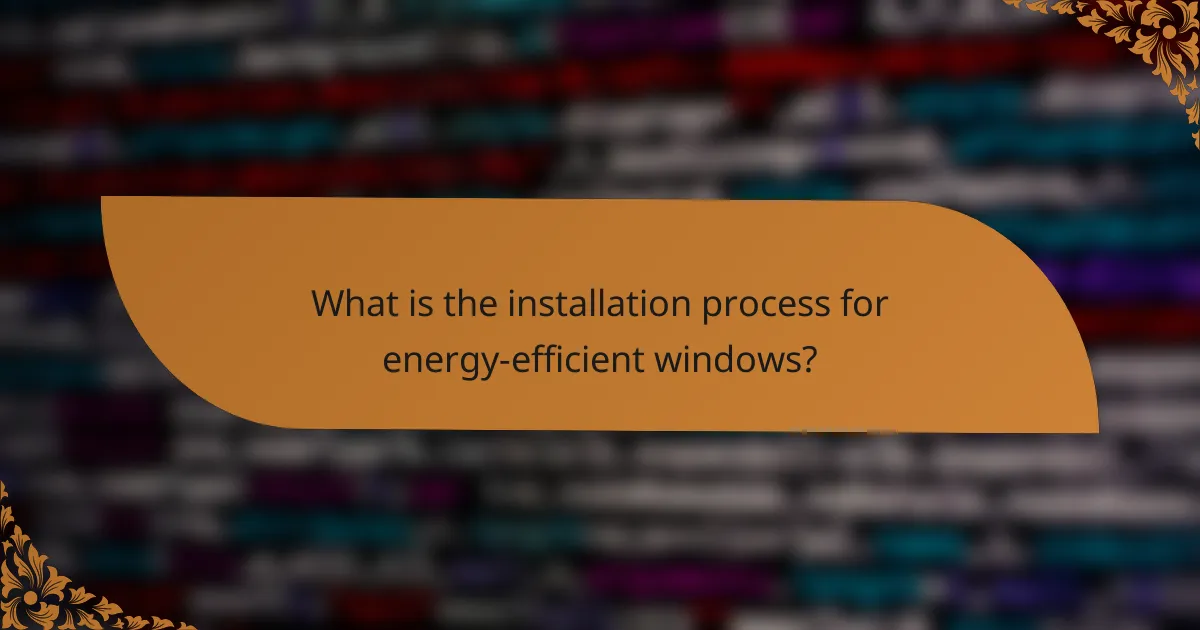
What is the installation process for energy-efficient windows?
The installation process for energy-efficient windows involves several key steps to ensure proper fitting and optimal performance. This process typically includes measuring the existing window openings, removing old windows, installing the new energy-efficient units, and sealing them to prevent air leaks.
Step 1: Measurement
Accurate measurement is crucial for a successful window installation. Begin by measuring the width and height of the existing window frame from multiple points to account for any irregularities. Ensure that you record the smallest measurements to avoid gaps when the new windows are installed.
Consider using a level to check for any tilt in the frame, as this can affect the installation of the new windows. Proper measurements will help you select the right size and style of energy-efficient windows that fit your home.
Step 2: Removal of old windows
Carefully removing old windows is essential to prepare for the new installation. Start by taking out any window treatments and hardware, then use a pry bar to detach the window frame from the wall. Be cautious to avoid damaging the surrounding structure during this process.
Once the old window is out, inspect the frame for any signs of rot or damage. If the frame is compromised, it may need repairs before installing the new energy-efficient windows.
Step 3: Installation of new windows
Installing the new energy-efficient windows involves placing them into the prepared openings. Begin by positioning the window into the frame and ensuring it is level and plumb. Use shims to adjust the fit as necessary, making sure the window operates smoothly.
Secure the window in place with screws or nails, following the manufacturer’s guidelines. It’s important to check that all components are aligned correctly to maintain the window’s energy efficiency and functionality.
Step 4: Sealing and finishing
After the new windows are installed, sealing is crucial to prevent air leaks and enhance energy efficiency. Apply a high-quality caulk around the exterior edges of the window frame to create a weather-tight seal. This step helps in reducing heating and cooling costs by minimizing drafts.
Finally, finish the installation by adding any interior trim or finishing touches. Ensure that the windows are clean and free from debris, which can affect their performance. Regular maintenance checks will help maintain their efficiency over time.
